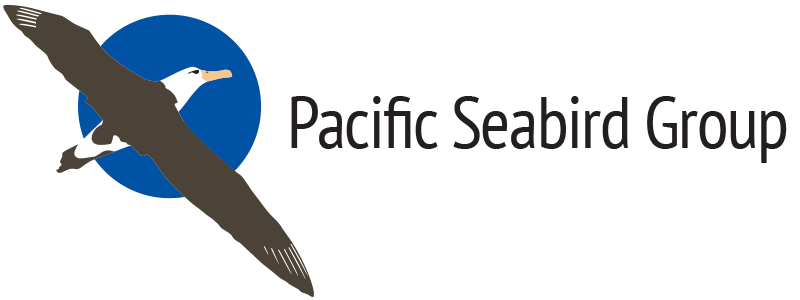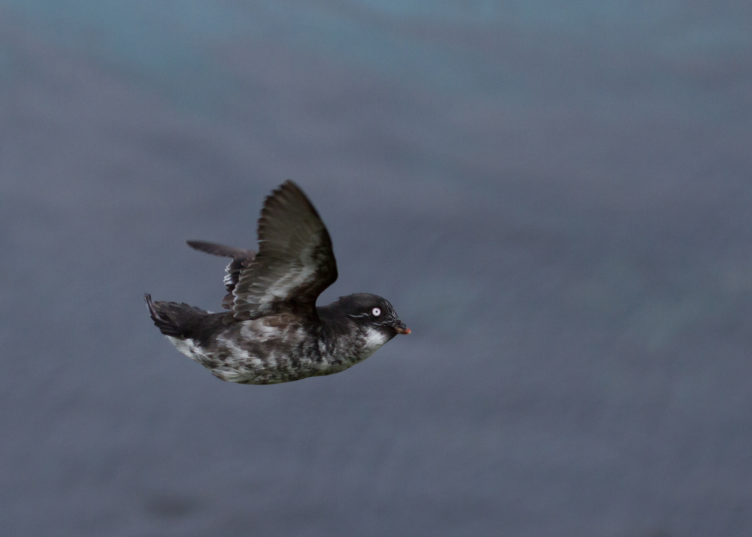Insights into the year-round behaviour of common murres at breeding sites
By Sophie Bennett, British Trust for Ornithology (BTO), The Nunnery, Thetford, Norfolk, IP24 2PU (sophie.bennett@bto.org)
The year-round cycle of the behaviour of many seabird species is clear and consistent: birds breed at large mixed colonies in the breeding season, rear their chicks, and then depart to the sea until the next breeding season. Common murres, Uria aalge hereafter “murres”, are generally accepted as having this typical behaviour cycle. However, it is becoming apparent that individuals at several populations at the southern extent of the species’ range return to occupy breeding sites outside of the breeding season (Figure 1; Boekelheide et al., 1990; Harris, 1984; Sinclair, 2018). On the Isle of May, Scotland, birds may return from autumn onwards for varying periods of time, generally arriving just after dawn (Harris & Wanless, 1989; Harris & Wanless, 2016). There are also numerous additional anecdotal accounts of murres occupying sites in the nonbreeding season in populations around the United Kingdom (UK) including in the UK’s largest murre colony, Rathlin Island (Northern Ireland), as well as in colonies in the North of England and off the Welsh Coast (James Crymble and Linda McKenzie pers. comms.) and further afield on the Farallon Islands (California; Boekelheide et al., 1990). It is likely that this behaviour also occurs at other colonies but has not been formally recorded.
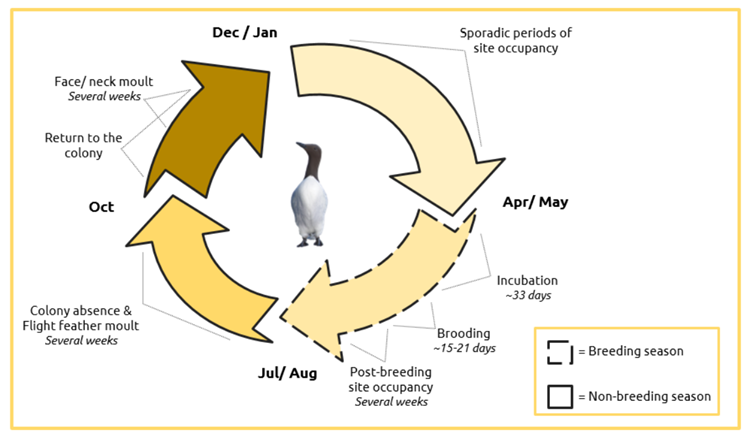
However, how often murres come back to the colony in the non-breeding season, why they do this, if they benefit, or if they suffer costs from this behaviour has, until very recently, been unknown. We know that in other bird species, more time spent in site defence during the breeding season can result in individuals obtaining or retaining a more desirable breeding site and breeding more successfully (Morales et al., 2014). Further, the occupancy of breeding sites in the non-breeding season can relate to fitness; sites that were previously successful were occupied more frequently in early autumn and may subsequently be more successful (Harris & Wanless, 1989). Consequently, given the territorial nature of murres, the securing of a desirable breeding site and associated fitness benefits have been suggested as possible motivations for this behaviour.
To investigate why birds return to their breeding sites over winter, and investing so much time in doing so, we set out to test how site occupancy in the non-breeding season related to site quality, breeding timing, and breeding success of murres on the Isle of May in Scotland. Using time-lapse photography, we recorded occupancy at breeding sites from October to March over three consecutive non-breeding seasons. We then monitored the successive breeding timing (lay date) and breeding success at each site to investigate how the occupancy behaviour may relate to future fitness measures.
We found that, on average, sites were first occupied in late October (c. 3 months after departing the colony in the breeding season). Sites were thereafter occupied on 46 ± 18% of days in the non-breeding season and for 55 ± 15% of the time. This degree of intensity of site occupancy behaviour was completely unprecedented and indicated a huge investment in both time and energy to be present at sites.
Higher-quality sites, sites with higher average historic breeding success, were occupied earlier, more frequently and for longer daily durations (Figure 2). Laying was also earlier at sites that were occupied more frequently, and sites occupied earlier were more successful, supporting the idea that individuals were returning to the colony to obtain and defend breeding sites.

It was surprising however that there was such variation between sites in investment in occupancy behaviour, despite clear benefits. To investigate this further we next considered that occupancy may also have net negative consequences for murres. For example, increased time in occupancy for murres may result in more time in flight commuting between the colony and foraging grounds and less time for foraging and resting. Flight is particularly energetically costly in murres resulting from their high wing-loading (Thaxter et al., 2010). Occupancy may then indirectly increase the energetic expenditure of individuals that could ultimately affect fitness. How individuals may be able to optimise occupancy to buffer against costs and take advantage of such benefits may have further consequences for population level fitness.
To address this next stage of investigation into this fascinating behaviour, we investigated how non-breeding occupancy of breeding sites is related to at-sea distribution, and how much energy and time individuals allocate to behaviours throughout the non-breeding season. We used bird-borne geolocators and time-depth recorders to record distribution and estimate time allocated to behaviours including occupancy, flight and foraging.
Firstly, we demonstrated that individuals were very variable in their occupancy behaviour (Figure 3).
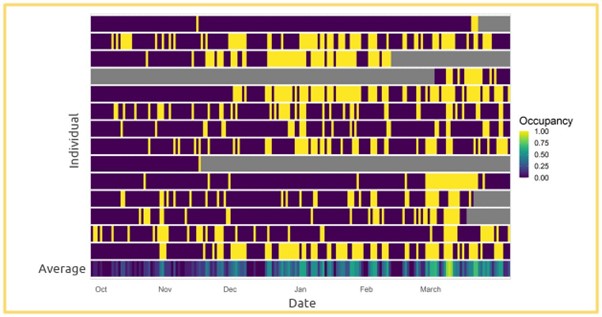
Individuals that remained nearer to the colony before their first return then returned earlier and had shorter bouts of absence thereafter. Crucially, when investigating why all individuals did not equally allocate effort into occupying sites, we found individuals also experienced a trade-off in the time and energy spent in occupancy or foraging. This trade-off indicated that an individual’s ability to forage efficiently may affect their ability to undertake occupancy (Figure 4).
Overall, we showed that occupancy is important for murres, returning earlier and occupying more often results in obtaining a better breeding site, and breeding more successfully. However, individuals differ in their ability to undertake occupancy likely mediated by variation in foraging efficiency, a measure of individual quality. Given that this behaviour can be hugely beneficial for the birds, it will be an important component of their annual cycle. This means we should start considering this behaviour when exploring the population demography and behaviour of this species.
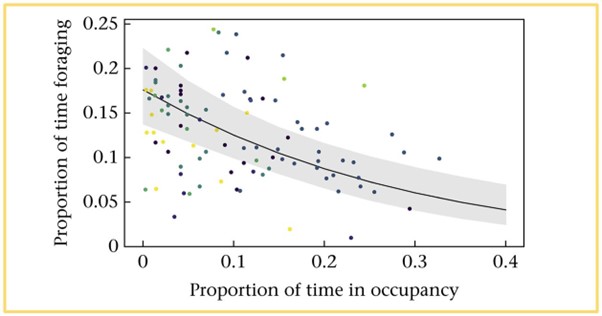
While through this work we have greatly improved understanding of this behaviour, there is still much for us to learn of course to fully comprehend how this behaviour, and any variation therein, may affect population fitness, not limited to: How does this behaviour vary between years in response to environmental conditions? What are the consequences of this behaviour not occurring?
We’re also keen to hear about this behaviour at other colonies and to collaborate on exploring the variation in and drivers of this behaviour more—do get in touch if you’d like to contribute on this.
References
Boekelheide, R. J., Ainley, D. G., Morrell, S. H., Huber, H. R., & Lewis, T. J. (1990). Common Murre. In Seabirds of the Farallon Islands. Stanford University Press.
Birkhead, T. R., & Taylor, A. M. (1977). Moult of the Murre Uria Aalge. Ibis, 119(1), 80–85. https://doi.org/10.1111/j.1474-919X.1977.tb02048.x
Bennett, S., Harris, M. P., Wanless, S., Green, J. A., Newell, M. A., Searle, K. R., & Daunt, F. (2022). Earlier and more frequent non-breeding colony attendance increases breeding success in a colonial seabird. Ecology and Evolution, 12(e2913). https://doi.org/10.1002/ece3.9213
Bennett, S., Daunt, F., Searle, K.R., Harris, M.P., Buckingham, L., Duckworth, J., Dunn, R.E., Wanless, S., Newell, M.A. and Green, J.A., 2024. Distribution and time budgets limit occupancy of breeding sites in the nonbreeding season in a colonial seabird, Animal Behaviour, 216, 213-233, https://doi.org/10.1016/j.anbehav.2024.07.023
Dunn, R. E., Wanless, S., Daunt, F., Harris, M. P., & Green, J. A. (2020). A year in the life of a North Atlantic seabird: Behavioural and energetic adjustments during the annual cycle. Scientific Reports, 10(1), Article 1. https://doi.org/10.1038/s41598-020-62842-x
Harris, M. P. (1984). Monitoring winter attendance of murres at breeding colonies. Annual Report Institute of Terrestrial Ecology, 1984, 73–74.
Harris, M. P., & Wanless, S. (1989). Fall Colony Attendance and Breeding Success in the Common Murre. The Condor, 91(1), 139–146. https://doi.org/10.2307/1368157
Harris, M. P., & Wanless, S. (2016). The use of webcams to monitor the prolonged autumn attendance of murres on the Isle of May in 2015. Scottish Birds, 36, 3–9.
Morales, M. B., Casas, F., García de la Morena, E., Ponjoan, A., Calabuig, G., Martínez-Padilla, J., García, J. T., Mañosa, S., Viñuela, J., & Bota, G. (2014). Density dependence and habitat quality modulate the intensity of display territory defence in an exploded lekking species. Behavioral Ecology and Sociobiology, 68(9), 1493–1504. https://doi.org/10.1007/s00265- 014-1758-z
Thaxter, C. B., Wanless, S., Daunt, F., Harris, M. P., Benvenuti, S., Watanuki, Y., Grémillet, D., & Hamer, K. C. (2010). Influence of wing loading on the trade-off between pursuit-diving and flight in common murres and razorbills. Journal of Experimental Biology, 213(7), 1018– 1025. https://doi.org/10.1242/jeb.037390
Sinclair, N. (2018). Remote time-lapse photography to monitor attendance of auks outside the breeding season at two colonies in the Northern Isles of Scotland (Research Report No. 1017). Scottish National Heritage.
